Poaching eggs can seem like a daunting task, especially when you're faced with common problems like runny whites, broken yolks, or eggs that just won't hold their shape.
But fear not, this article is here to help you troubleshoot egg poaching and guide you towards achieving that perfect, restaurant-quality poached egg every time.
Common Problems and Solutions
Problem 1: Runny Whites
If your poached eggs are ending up with runny whites, it's likely that your eggs aren't fresh enough. Fresh eggs have tighter whites and yolks that retain their shape better when cooked.
Always check the freshness of your eggs before poaching. A quick tip to check freshness is to place an egg in water; if it sinks and lies flat, it's fresh.
Problem 2: Broken Yolks
Broken yolks can be a disaster when poaching eggs. This often happens when eggs are cracked directly into the water.
Instead, crack your eggs into a bowl or ramekin before gently sliding them into the water. This reduces the impact on the yolk and helps prevent breakage.
Problem 3: Eggs Not Holding Their Shape
If your eggs are spreading out in the water and not holding a neat shape, try straining the watery part of the egg white before poaching.
Using a fine-mesh strainer, you can remove the thin, watery part of the egg white, leaving behind the thicker white that will hold a better shape during poaching.
Additional Tips for Perfect Egg Poaching
Tip 1: The Right Water Temperature
The right water temperature is key to successful poaching. Water that's not hot enough can cause the eggs to dissolve into the water before they set, resulting in a murky pot of milky water.
On the other hand, water that's boiling too rapidly can cause the egg to jiggle around too much, leading to disintegration of the whites.
Aim for a temperature of 180°F (82°C) for cleaner, more tender cooking.
Tip 2: Use of Vinegar
Adding vinegar to the poaching water can help the egg whites set properly. However, be careful not to add too much as it can affect the taste of the eggs.
A teaspoon or two should be enough for a pot of water.
Tip 3: The Whirlpool Method
The whirlpool method involves swirling the water into a vortex before dropping in the egg. This helps to wrap the egg white around the yolk, resulting in a neatly shaped poached egg.
This method works best when poaching one egg at a time.
Poaching eggs doesn't have to be a challenge. By understanding the common problems and how to solve them, you can master the art of egg poaching. Remember, practice makes perfect, so don't be disheartened if your first few attempts don't turn out as expected. Keep trying, and soon you'll be poaching eggs like a pro.
If you're looking for a new egg poacher or perhaps buying your first one, check out our article on the best egg poachers for our top 5 recommendations.
Once you've mastered the basics and overcome any challenges, you might want to refine your technique. Our article, How to Make Excellent Poached Eggs with an Egg Poacher Pan, can help you take your poaching skills to the next level.
FAQs
Why are my poached eggs always separating?
This is likely due to the eggs not being fresh enough. Fresh eggs have tighter whites that hold together better during poaching.
What are the common mistakes when poaching eggs?
Common mistakes include not using fresh eggs, cracking eggs directly into the water, and not using the right water temperature.
Why don't my poached eggs float?
Poached eggs should sink to the bottom of the pot and not float. If your eggs are floating, it could be a sign that they are not fresh.
Why add vinegar to the poaching liquid for poached eggs?
Adding vinegar to the poaching liquid helps the egg whites to set more quickly, resulting in a better-shaped poached egg.
Further Reading
- How to Make Excellent Poached Eggs with an Egg Poacher Pan: Learn how to make perfect poached eggs using an egg poacher pan.
- A Look Back at the History of Egg Poaching: Dive into the fascinating history of egg poaching and how it has evolved over the years.
- How to Make Poached Eggs without a Poacher: Discover alternative methods of poaching eggs without a dedicated egg poacher.



